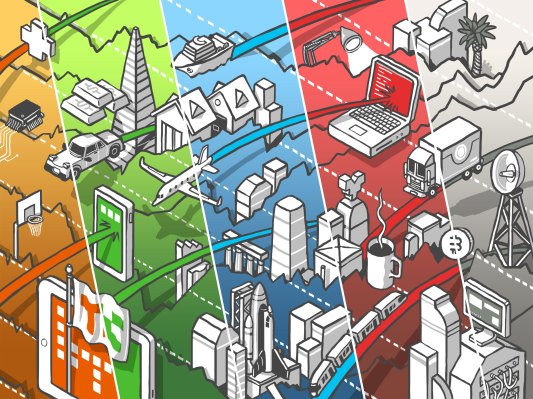W
elcome to the TechCrunch Exchange, a weekly startups-and-markets newsletter. It’s inspired by the daily TechCrunch+ column where it gets its name. Want it in your inbox every Saturday? Sign up here.
Enterprise cloud spend is holding up well, but large companies are looking into vendor consolidation. This makes cloud marketplaces an increasingly relevant sales channel for B2B startups. — Anna
Beyond the good news: Headwinds for early-stage enterprise startups
Battery Ventures’ state of cloud software spending report contained some good news for startups hoping to sell software to enterprise clients. Contrary to gloomy claims, “reports of the death of enterprise tech spending have been greatly exaggerated,” the VC firm said.
Our own Alex Wilhelm delved into these findings for The Exchange earlier this week and confirmed the good news: The sky isn’t falling for cloud software spend. However, there are headwinds ahead for startups because money just isn’t flowing as freely as it used to.
Indeed, the recession is having an impact on how large companies plan to buy software.
For instance, the report noted, “CXOs are tightening restrictions on self-procurement, even in the dev/test environment.”
This data point is concerning for the growing number of vendors who rely on a bottom-up sales motion, in which a service gets adopted by individuals or teams before being sold to the organization more broadly. (This is also known as product-led growth, or PLG.)
Hearing that devs are getting less leeway to pick their own tools led Battery to predict that “bottoms-up and PLG [sales motions] will experience headwinds as buyers become more conservative.”
Software startups and SaaS companies will likely be the most affected in the short-term: Per Battery, these “have readily embraced [PLG] and bottoms-up adoption as part of their go-to-market strategies in recent years.” This sales motion may still be the right choice in the long-term but could make the next few months trickier to navigate.
It is also worth keeping in mind that giant corporations aren’t fond of buying from much smaller, younger teams in the first place. Among Battery’s sample, consisting of 100 CXOs representing some $30 billion in annual technology spend, only one-third of companies reported procuring software from early-stage companies.
Another finding of the report is that the vast majority of respondents planning to reduce their cloud spend hope to do so through vendor consolidation and SaaS license optimization. Again, not great news for smaller vendors. But these might find a useful workaround by leveraging cloud marketplaces.
Piggybacking the open bar tab
Cloud marketplaces can be likened to app stores curated by the three dominant cloud service providers (CSPs) — Amazon’s AWS, Microsoft’s Azure and Google Cloud Platform — as well as by others such as IBM-owned Red Hat.
Major software vendors are leaning into this opportunity; a quick look at Google Cloud’s console shows names ranging from Confluent and MongoDB to Databricks and Elastic.
“Cloud marketplaces aren’t just one more channel for selling software — it’s becoming the channel,” Andreessen Horowitz general partner Martin Casado wrote in March 2021 as the firm invested in Tackle.
The Idaho-based startup, which became a unicorn since then, helps others sell through cloud marketplaces. Tackle also releases an annual report on the state of cloud marketplaces and noted a clear evolution between 2021 and 2022.
“In 2021, we found that the uptake on Cloud Marketplace adoption had shifted from an early adopter pattern to a mainstream part of go-to-market systems. This year, it’s clear that, more than ever, the clouds represent a massive opportunity to drive significant revenue for B2B organizations and become the center of the modern go-to-market system.”
Conversely, among Battery’s respondents, 63% of the surveyed companies already procure software through cloud marketplaces, with standardized onboarding, governance and internal budget access as key drivers for buying via this channel.
For startups, though, cloud marketplaces haven’t always been a high-priority sales channel. Perhaps with reason, as it could commoditize their offering or distract them from finding actual product-market fit. But in a recession, these trade-offs start weighing in less than they used to.
Battery Ventures definitely noted a marked change in its own portfolio, its business development partner, Scott Goering, told The Exchange.
“At the end of last year, there were multiple portfolio companies that had never really leaned into the cloud service provider marketplaces that ended up closing [big deals.] I can think of one that closed a three quarter million dollar net new deal. There were others that [had] five or six deals [that] added up to about the same amount.” (That’s $750,000, by the way.)
The main tailwind in favor of this channel is that enterprise clients have already committed a budget to a particular CSP — which they can also use to buy through cloud marketplaces. (There’s some nuance to it, but generally speaking, it counts at least partially toward their commitment, as CSPs also want to encourage spending through their cloud marketplaces.)
Goering shared an analogy: “I think there’s an opportunity for people to go after some of those committed cloud spend. As one person put it, you know, the tab is open at the bar, why not go buy it from there? So we are seeing startups [selling] across all three cloud providers.”
Where it gets even more interesting is that the cake is getting bigger: “32% of CXO respondents expect to spend more with CSP marketplaces in 2023 than they spent in 2022,” Battery found out, compared to only 8% who plan to reduce their budget.
The tailwinds for startups to explore cloud marketplaces were already here, but this new data point is another incentive for founders to give them a try.
